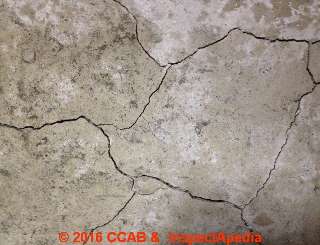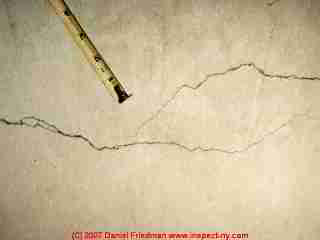 How to Identify, Evaluate & Repair Shrinkage Cracks in Poured Concrete
How to Identify, Evaluate & Repair Shrinkage Cracks in Poured Concrete
- POST a QUESTION or COMMENT about cracks in poured or placed concrete slabs: shrinkage crack recognition, diagnosis, evaluation in concrete
Concrete shrinkage cracks:
How to identify, evaluate, & repair shrinkage cracks in concrete floors,slabs, or foundations. We address these questions: Are concrete floor cracks a structural problem?
How to recognize and evaluate shrinkage cracks in poured concrete slabs or floors. Do shrinkage cracks in poured concrete walls or floor slabs always need repair?
This document explains how to recognize shrinkage, evaluate, and repair cracks in poured concrete walls or floors, and discusses a few (minor) possible problems from shrinkage cracking such as water or radon leaks.
InspectAPedia tolerates no conflicts of interest. We have no relationship with advertisers, products, or services discussed at this website.
- Daniel Friedman, Publisher/Editor/Author - See WHO ARE WE?
Guide to Shrinkage Cracks in Poured Concrete Slabs
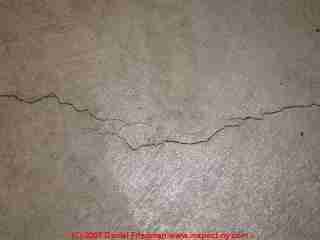
This article series discusses concrete cracking in slabs, walls, floors, and foundations, and describes the types of cracks that occur in poured ("placed concrete" by some experts) walls, slabs or floors and explains the risks associated with each, thus assisting in deciding what types of repair may be needed.
This article series describes how to recognize and diagnose various types of foundation failure or damage, such as foundation cracks, masonry foundation crack patterns, and moving, leaning, bulging, or bowing building foundation walls.
Types of foundation cracks, crack patterns, differences in the meaning of cracks in different foundation materials, site conditions, building history, and other evidence of building movement and damage are described to assist in recognizing foundation defects and to help the inspector separate cosmetic or low-risk conditions from those likely to be important and potentially costly to repair.
Shrinkage cracks
such as shown in our photograph above are found in poured concrete, are easily recognizable, and can be distinguished from other types of cracks that occur later in the life of a foundation wall or floor slab - as we explain here.
The photograph of cracks above were taken of shrinkage cracks in a concrete slab floor in a home built in 2006.
The cracks in this case ranged in width (measured across the crack) from "hairline" (less than 1/16") to about 3/32" in the basement floor slab of this particular home. They may appear larger.
What is unique about shrinkage cracks in concrete is that they usually appear to be discontinuous, as shown in this photo.
The crack will meander along in the concrete, taper to a stop, and then continue beginning in a parallel line to the first crack, meandering again through the concrete.
This is characteristic of concrete (or mud) shrinking while giving up its moisture.
In his Architect's Hand-Book on Cements Clarke (1899) described and offered this explanation for types of cracks occurring in concrete:
Shrinkage Cracks or "Contraction Cracks"
are due to faulty workmanship, and may occur in the best of cements if mixed too rich or if allowed to dry out too quickly, or if not thoroughly mixed and trowelled (A, in Fig. I.)
Expansion cracks
are due to too much free lime or magnesia in the cement. (B, Fig I.) If there is too much free carbonate of lime the trouble may be corrected by allowing the cement to season in the air to allow the frere lime to slake.
If there is too much sulphate of lime or magnesia the cement must be rejected as dangerous to use.
In our photo found earlier on this page you can see the shrinkage of even an otherwise-perfect concrete floor slab with no visible cracks in the field of its surface if the floor was poured inside of an existing foundation. Look for the gap between the edges of the slab and the foundation wall?
Look also for the stains or concrete debris on the wall at the slab level?
These confirm that at the time the slab was poured it was touching the wall.
Causes of variation in width of shrinkage cracks in poured concrete
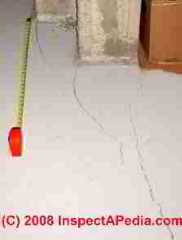 Why do concrete shrinkage cracks vary in width across a wall or floor?
Why do concrete shrinkage cracks vary in width across a wall or floor?
Probably because concrete shrinkage cracks are meandering or "wandering" in their path, and are usually intermittent or interrupted in their course, as you can see in the photograph above.
As the path of cracking caused by concrete shrinkage wanders and stops and starts across an area of wall or floor, you will often see overlapping or roughly parallel nearby cracks that represent the end of one crack line and the beginning of another.
The total width of the two close-by cracks is probably about the same as the total crack width where a crack wanders in solitary along the concrete.
The stresses producing the crack have simply shifted slightly in the wall or floor as it cured.
Why cracks appear to originate in poured concrete walls at windows or at outside corners in concrete floor slabs
Why do concrete shrinkage cracks often begin near the corner of a window, or in a floor near a corner in the foundation footprint?
If you think of the entire reinforced concrete wall or floor as a rather uniform membrane, any discontinuity in the membrane, such as an opening for a window or the placement of a corner projecting into the room in the case of a floor, creates a variation in the distribution of (shrinkage during curing) forces in the wall or floor.
Shrinkage cracks may have their origin at these points of discontinuity.
Watch out: other more varigated concrete crack patterns (shown below) may be ascribed
to FOUNDATION DAMAGE by MATERIAL or INCLUSIONS
producing crack patterns in concrete caused by inclusion of iron sulfide (pyrrhotite) particles in the concrete mix.
Above: a photograph of foundation cracks attributed to concrete that included iron sulfide (pyrrhotite), provided courtesy of CCACB - Connecticut Coalition Against Crumbling Basements.
This crack pattern is rather distinctive: somewhat random cracking pattern, with concrete cracks that are wider and more continuous than the usual concrete shrinkage cracks found at many jobs
For details about pyrrhotite inclusion cracking and other masonry cracks caused by other inclusions
see FOUNDATION DAMAGE by MATERIAL or INCLUSIONS
Excerpting from that article:
Iron sulfide mineral (pyrrhotite) cracking may appear as variegated, "random pattern" cracking in concrete slabs, walls, and foundations whose concrete contains high levels of pyrrhotite. Moisture as well as oxygen react with this iron sulfide material, causing it to swell with tremendous force, causing varied-pattern cracking in the concrete.
Bryant in his thesis describes iron sulfide pyrrhotite cracking damage in several U.S. states including
in Canada: Ottawa,
in the U.K. in Derbyshire, and
in the U.S. in Kentucky, Mississippi, Montana, Pennsylvania, Tennessee, Texas, Virginia,
and more generally in the U.S. Great Plains area and in the Mississippian and Pennsylvanian shale beds.
Bryant notes that cases of "... heave due to oxidation of pyritic shale have been reported and continue to be reported worldwide. " (Bryant 2003).
Different concrete shrinkage cracks that appear as gaps between the floor slab and wall along a building foundation wall are described
at SHRINKAGE CRACKS at FOUNDATION WALLS.
What is the significance of differences in concrete height on opposite sides of a crack?
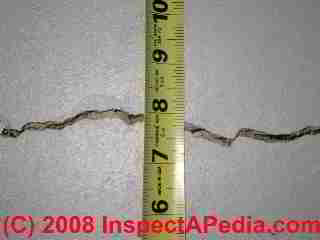
Why are some "shrinkage cracks" at different heights on either side of the crack?
The floor on one side of this 3/16" wide crack was about 3/32" higher than on the other.
This may be due to settlement of the broken slab section on poorly-compacted fill in the building's basement.
Multiple forces and movements may be present as a poured concrete foundation cures, such as a combination of shrinkage and settlement, or shrinkage and outside pressures on a wall from backfill.
It's best to let any masonry wall cure before backfilling, though that's most critical with masonry block (CMU) walls where early backfill before the first floor has been framed in place has been known to lead to a total collapse of the foundation.
In a poured concrete wall or floor if the surface of the concrete on opposite sides of a crack are also at different elevations, that is if the concrete on one side of a crack is higher than the other, additional forces have been at work and the crack is not a simple shrinkage crack.
Repair cracks that make trip hazards:
If the height difference across a floor crack is 1/8" or more it forms a tripping hazard and it should be repaired.
Do we need to repair shrinkage cracks in foundation walls or slabs?
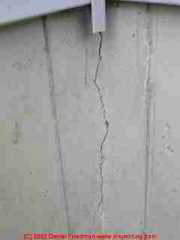
Small shrinkage cracks that are above ground
level in a foundation wall, such as the cracks
in the inside corner of this poured concrete foundation are unlikely to be much of a problem except for
a few less common cases where water running down the wall is leaking in at the shrinkage crack.
[Do you think that the crack shown here is an initial footing or foundation settlement crack? Maybe so.]
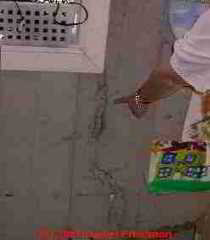
Shrinkage cracks in concrete walls or floor slabs that are leaking into the building interior
such
as the one shown in this photograph, should be sealed.
However a careful inspection in this particular case revealed that the window flashing and exterior siding had been installed so as to direct wind-blown rain into a concentrated runoff pattern that [unfortunately] passed over and then through this crack in the foundation wall. Some flashing and siding adjustments outside cured this problem.
Concrete cracks often occur at natural stress points
where the uniformity of a poured concrete wall or
floor has been interrupted by placement of a window (in walls of course) or inside corners (in floors). You may
often find shrinkage cracks that trace across the concrete to these stress points.
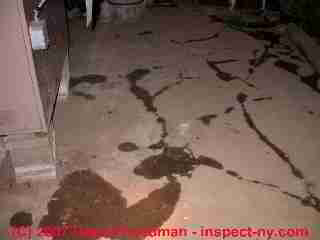
Shrinkage cracks in a concrete slab or floor might need to be repaired to avoid water leakage from below or to stop radon gas entering the building. In the photograph shown here the floor was badly cracked from a combination of concrete shrinkage, settlement, and frost heaves (the building had been left un-heated in a freezing climate).
You can see that lots of water was leaking into the basement up through the floor.
In this case, while repairs to the basement floor, or perhaps better, a new basement floor slab, were in order, the root cause of high water levels under the basement floor needed to be addressed first.
How are concrete wall, foundation, or floor slab shrinkage cracks avoided or repaired
While shrinkage in poured concrete walls or floor slabs is a normal property of curing concrete, shrinkage cracks can be controlled, or where they have occurred, in some cases repairs are needed. In addition to reading about repairing concrete shrinkage cracks (if crack repair is needed at all)
also
see how we prevent shrinkage cracks
in poured concrete floors and walls by
reading CONTROL JOINT CRACKS in CONCRETE
Research on Concrete Cracks
- Also see the Recommended Articles listed at the end of this article
- Clarke, Addison Henry. Architect's Hand-book on Cements. WW Clarke & son, 1899. [Available from Google Play as a free eBook]
Excerpts:
Roman Cement, originally called Parker's Cement, is made from nodules found in certain places on the English coast. The composition of this rock is quite similar to that from which Natural Rock Cement is made in the United States. (p. 12)
...
Parker's "Roman" Cement was discovered in 1796 (p. 8)
...
It was not until about 1848 that Portland cement begasn to be well known in the London market. At this time Mr. I. C. Johnson discovered the proper mixture of lime and clay to make Portland Cement, and also the secret of burning the clinker to the point of vitrification to secure the best results. ... The United Stats was late in the field. Portland Cement began to be importted into this country about the year 1865, when it was sold at from $5 to $7 perbarrel.
It was not until the year 1872 that Mr. David O. Saylor succeeded in producting a Portland Cement from argillaceous limestone that he had been employing in the manufacture of Natural Rock Cement.
and further excerpted
at CONCRETE FOUNDATION, WALL, SLAB DEFECTS
...
Continue reading at CONCRETE SLAB CRACK REPAIR or select a topic from the closely-related articles below, or see the complete ARTICLE INDEX.
Or see SHRINKAGE CRACKS in SLABS FAQs - questions & answers posted originally at the end of this article.
Or see these
Recommended Articles
- CONCRETE COLD POUR JOINTS
- CONCRETE CORROSION DUE TO HYDROGEN SULFIDE
- CONCRETE FOUNDATION, WALL, SLAB DEFECTS
- CONCRETE REINFORCEMENT, FIBER
- CONCRETE SHRINKAGE CRACKS
- CONCRETE SHRINKAGE CRACK REPAIR
- CONCRETE SLAB CRACK EVALUATION
- CONTROL JOINT CRACKS in CONCRETE
- FREEZING & WATER DAMAGED SLABS
- FROST HEAVE / EXPANSIVE SOIL CRACKS in SLABS
- SETTLEMENT CRACKS in SLABS
- SETTLEMENT vs. FROST HEAVE CRACKS
- SETTLEMENT vs. SHRINKAGE CRACKS
- SHRINKAGE CRACKS in SLABS
- SHRINKAGE CRACKS at FOUNDATION WALLS
- TEMPERATURE EFFECT on CONCRETE POUR
- CONCRETE SLAB CRACK REPAIR
Suggested citation for this web page
SHRINKAGE CRACKS in SLABS at InspectApedia.com - online encyclopedia of building & environmental inspection, testing, diagnosis, repair, & problem prevention advice.
Or see this
INDEX to RELATED ARTICLES: ARTICLE INDEX to BUILDING STRUCTURES
Or use the SEARCH BOX found below to Ask a Question or Search InspectApedia
Ask a Question or Search InspectApedia
Try the search box just below, or if you prefer, post a question or comment in the Comments box below and we will respond promptly.
Search the InspectApedia website
Note: appearance of your Comment below may be delayed: if your comment contains an image, photograph, web link, or text that looks to the software as if it might be a web link, your posting will appear after it has been approved by a moderator. Apologies for the delay.
Only one image can be added per comment but you can post as many comments, and therefore images, as you like.
You will not receive a notification when a response to your question has been posted.
Please bookmark this page to make it easy for you to check back for our response.
IF above you see "Comment Form is loading comments..." then COMMENT BOX - countable.ca / bawkbox.com IS NOT WORKING.
In any case you are welcome to send an email directly to us at InspectApedia.com at editor@inspectApedia.com
We'll reply to you directly. Please help us help you by noting, in your email, the URL of the InspectApedia page where you wanted to comment.
Citations & References
In addition to any citations in the article above, a full list is available on request.
...
Ask a Question or Search InspectApedia
Try the search box just below, or if you prefer, post a question or comment in the Comments box below and we will respond promptly.
Search the InspectApedia website
Note: appearance of your Comment below may be delayed: if your comment contains an image, photograph, web link, or text that looks to the software as if it might be a web link, your posting will appear after it has been approved by a moderator. Apologies for the delay.
Only one image can be added per comment but you can post as many comments, and therefore images, as you like.
You will not receive a notification when a response to your question has been posted.
Please bookmark this page to make it easy for you to check back for our response.
IF above you see "Comment Form is loading comments..." then COMMENT BOX - countable.ca / bawkbox.com IS NOT WORKING.
In any case you are welcome to send an email directly to us at InspectApedia.com at editor@inspectApedia.com
We'll reply to you directly. Please help us help you by noting, in your email, the URL of the InspectApedia page where you wanted to comment.
Citations & References
In addition to any citations in the article above, a full list is available on request.
- Bryant, Lee Davis, Matthew Mauldon, and James Kenneth Mitchell. Geotechnical problems with pyritic rock and soil. Virginia Polytechnic Institute and State University, Charles E. Via Department of Civil Engineering, 2003.
- [1] "Concrete Slab Finishes and the Use of the F-number System", Matthew Stuart, P.E., S.E., F.ASCE, online course at www.pdhonline.org/courses/s130/s130.htm
- [2] "Best Practices for Concrete Sidewalk Construction," Balvant rajani, Canadian National Research Council
- Building Pathology, Deterioration, Diagnostics, and Intervention, Samuel Y. Harris, P.E., AIA, Esq., ISBN 0-471-33172-4, John Wiley & Sons, 2001 [General building science-DF] ISBN-10: 0471331724 ISBN-13: 978-0471331728
- Building Pathology: Principles and Practice, David Watt, Wiley-Blackwell; 2 edition (March 7, 2008) ISBN-10: 1405161035 ISBN-13: 978-1405161039
- Diagnosing & Repairing House Structure Problems, Edgar O. Seaquist, McGraw Hill, 1980 ISBN 0-07-056013-7 (obsolete, incomplete, missing most diagnosis steps, but very good reading; out of print but used copies are available at Amazon.com, and reprints are available from some inspection tool suppliers). Ed Seaquist was among the first speakers invited to a series of educational conferences organized by D Friedman for ASHI, the American Society of Home Inspectors, where the topic of inspecting the in-service condition of building structures was first addressed.
- "Backfilling Basics," Buck Bartley, Journal of Light Construction, October 1994
- In addition to citations & references found in this article, see the research citations given at the end of the related articles found at our suggested
CONTINUE READING or RECOMMENDED ARTICLES.
- Carson, Dunlop & Associates Ltd., 120 Carlton Street Suite 407, Toronto ON M5A 4K2. Tel: (416) 964-9415 1-800-268-7070 Email: info@carsondunlop.com. Alan Carson is a past president of ASHI, the American Society of Home Inspectors.
Thanks to Alan Carson and Bob Dunlop, for permission for InspectAPedia to use text excerpts from The HOME REFERENCE BOOK - the Encyclopedia of Homes and to use illustrations from The ILLUSTRATED HOME .
Carson Dunlop Associates provides extensive home inspection education and report writing material. In gratitude we provide links to tsome Carson Dunlop Associates products and services.



